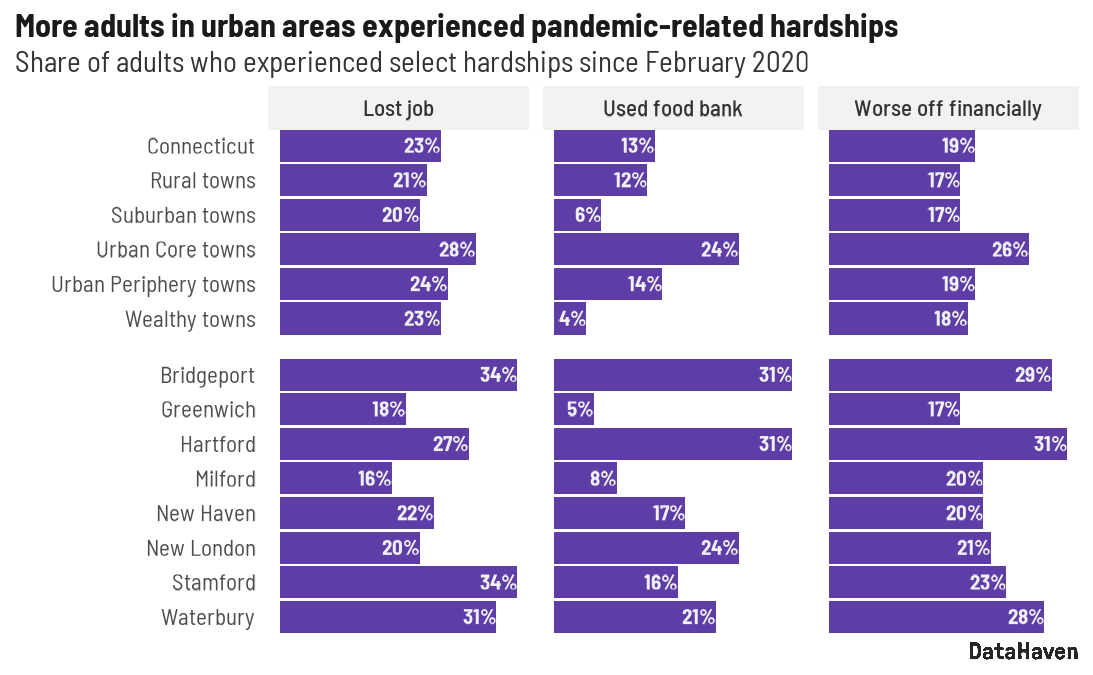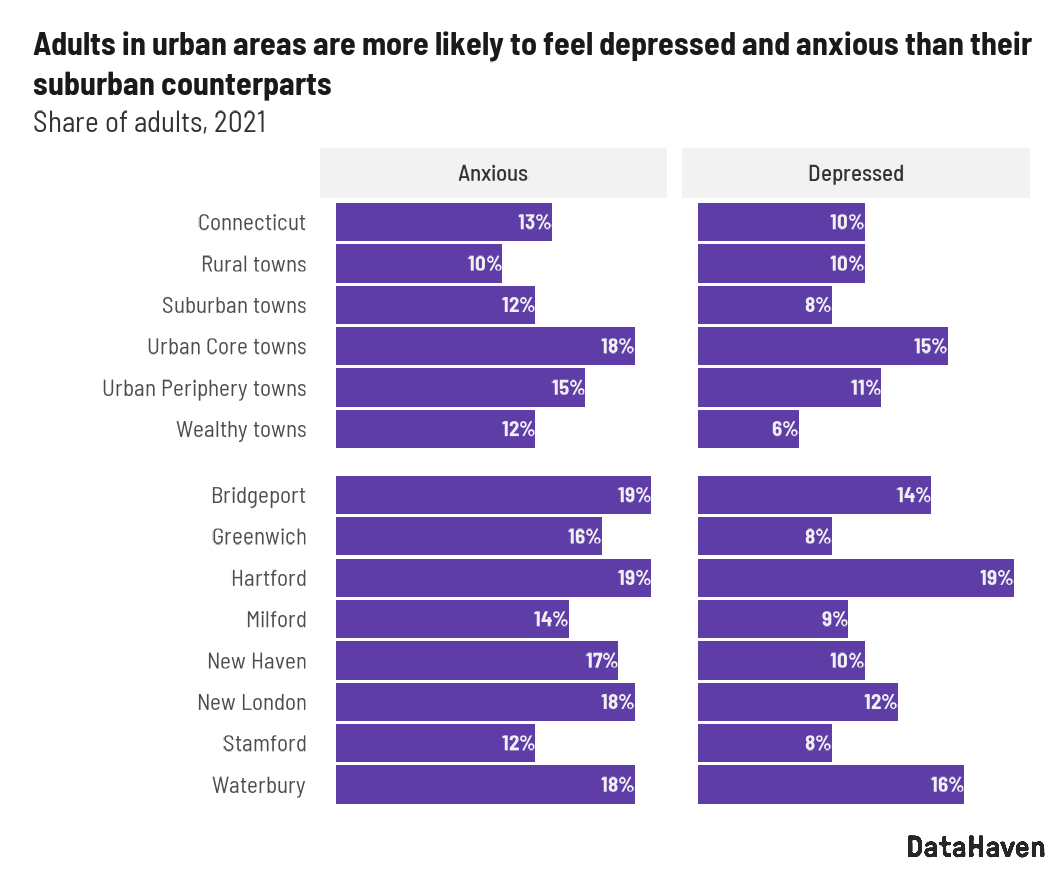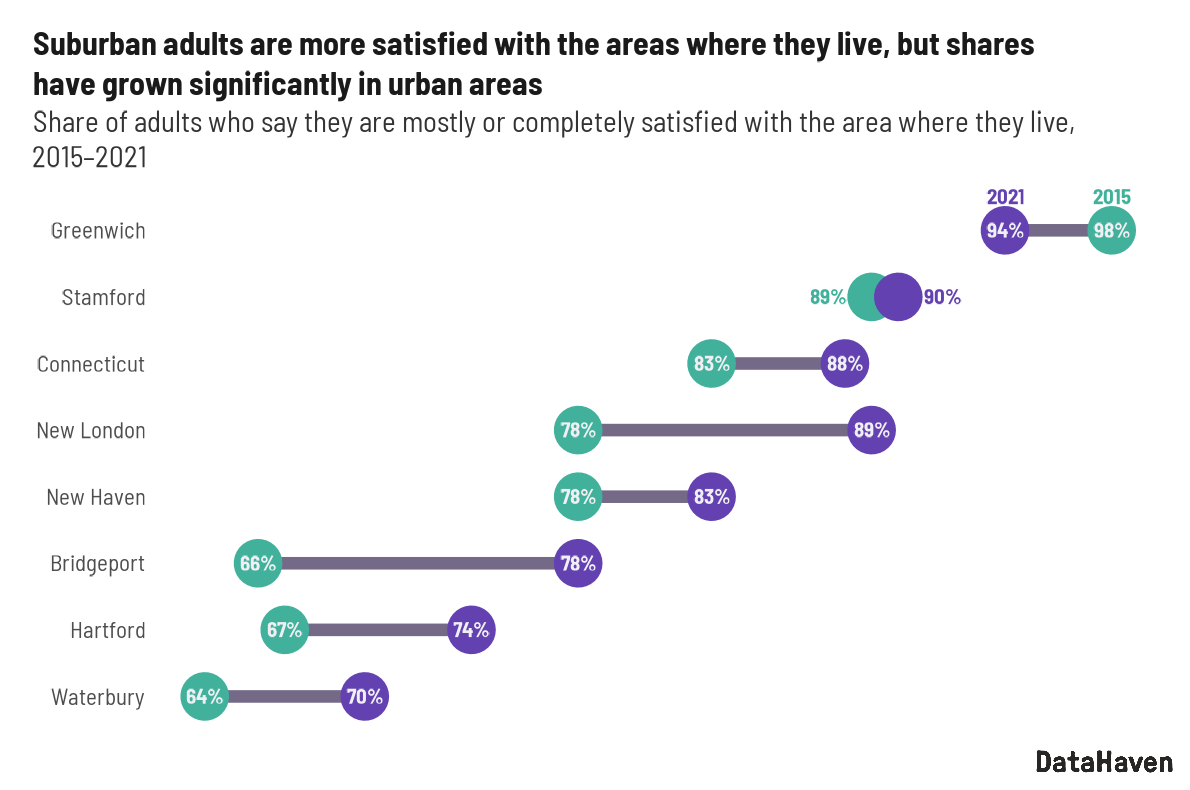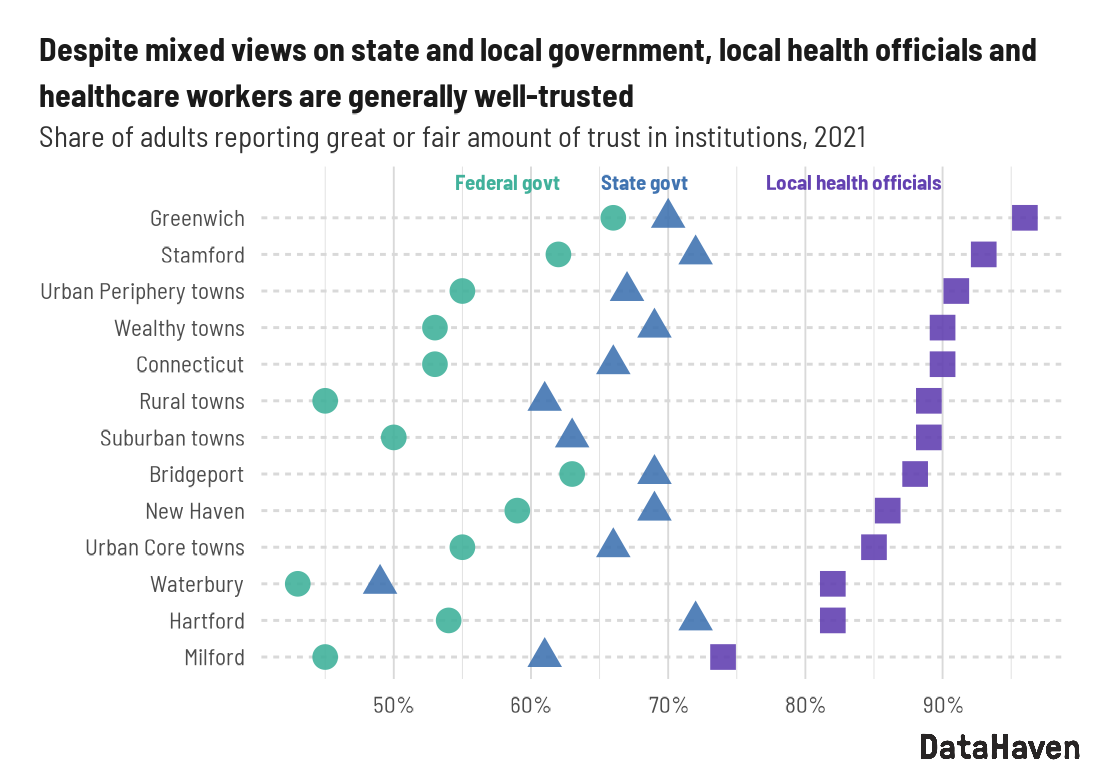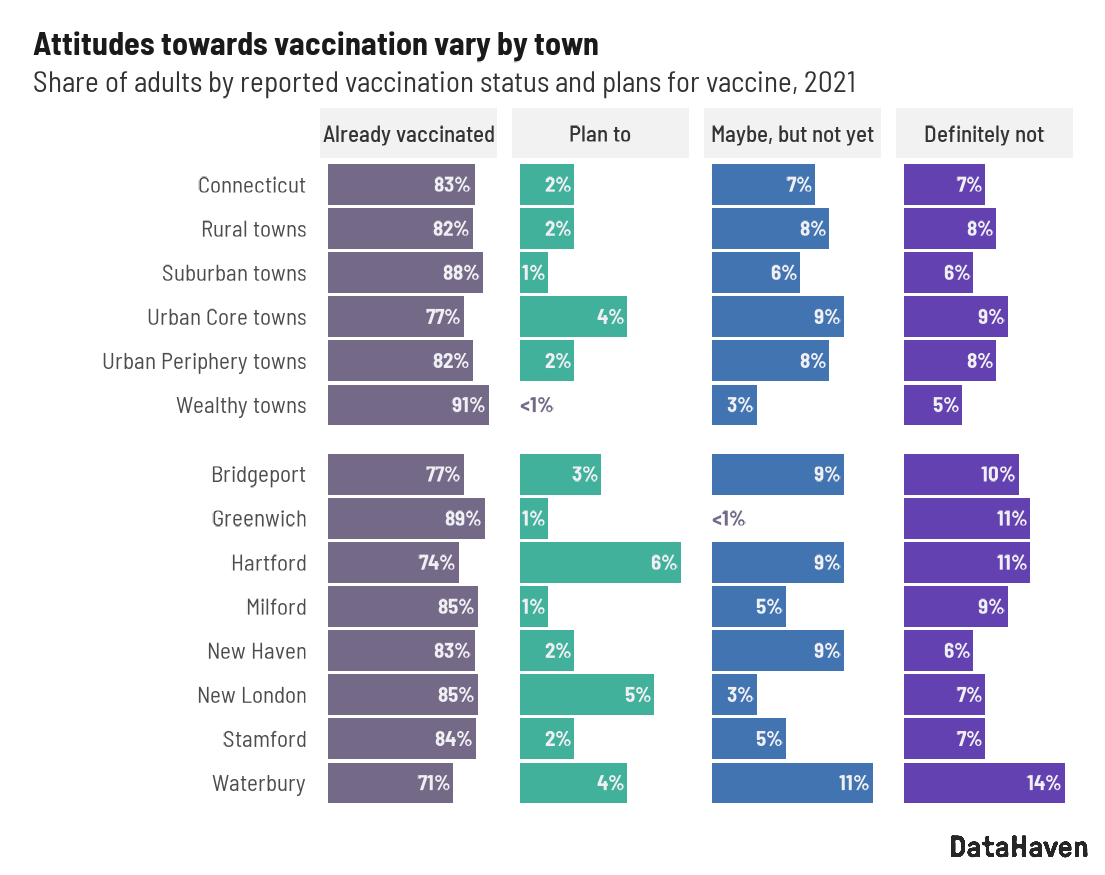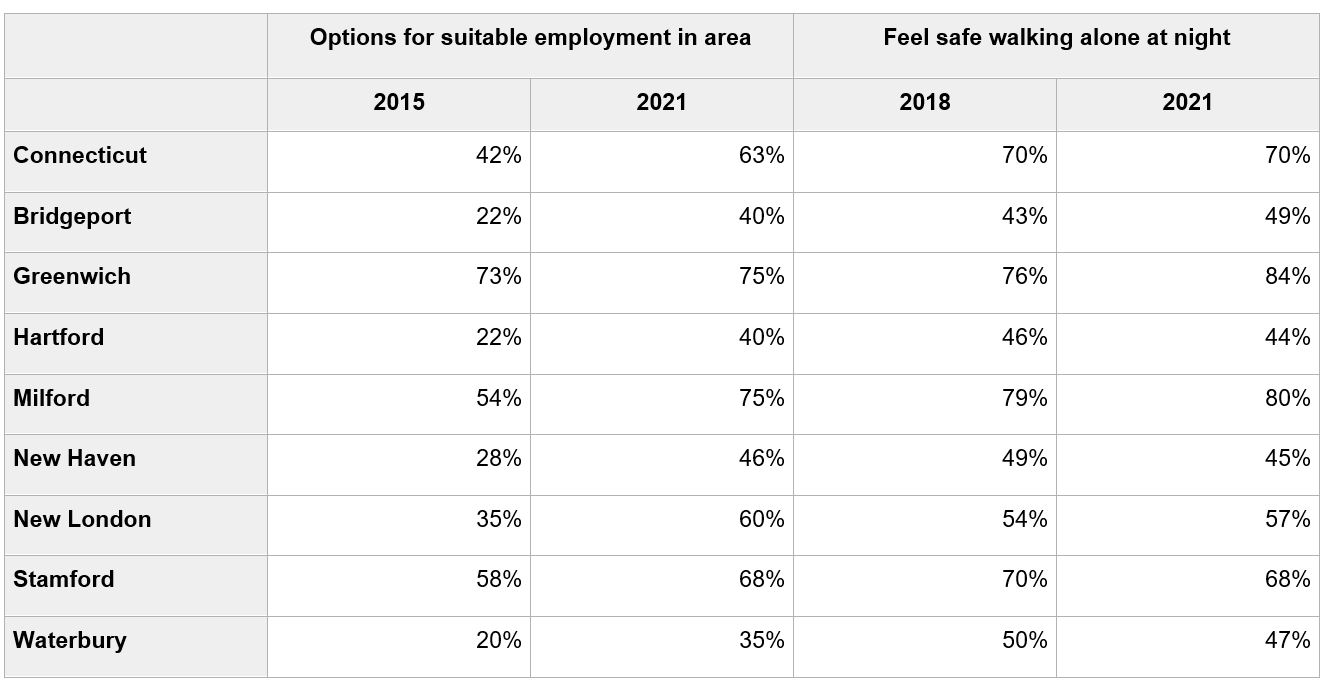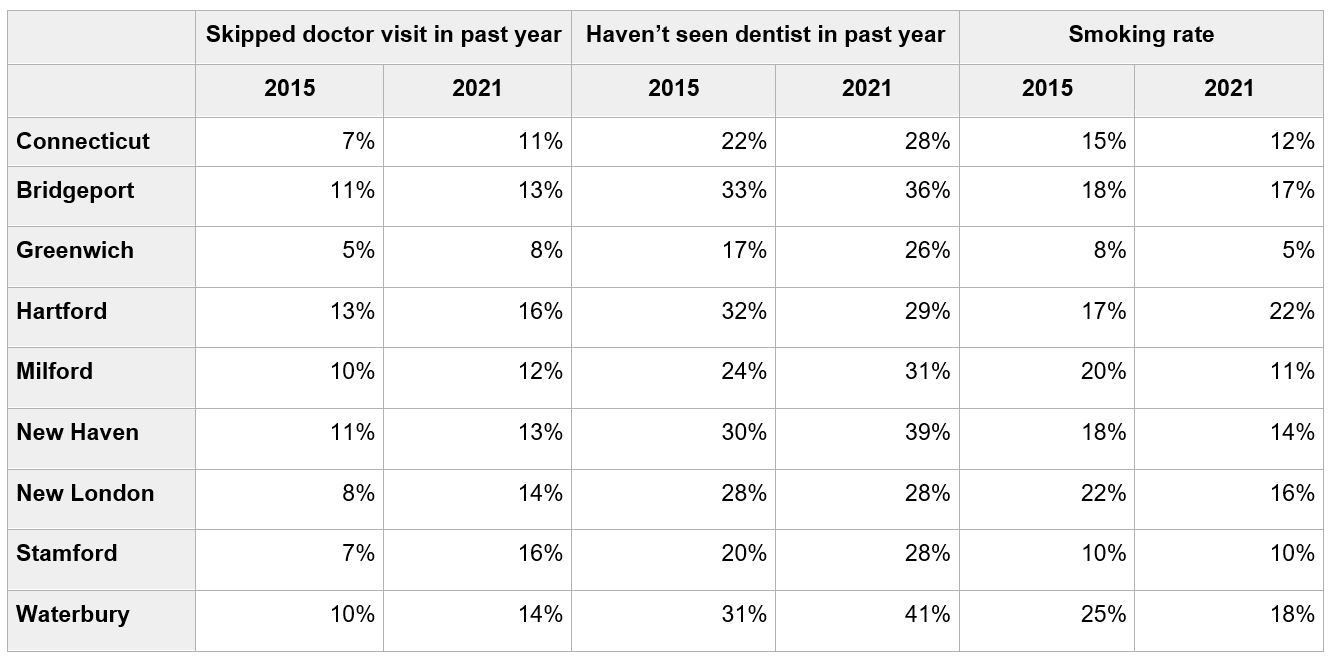All DataHaven Programs, Civic Vitality, Community Wellbeing Survey, Demographics, Economy, Education, Health, Housing, Public Safety
Survey results quantify how each Connecticut town experienced the pandemic throughout 2021
PRESS RELEASE – February 13, 2022
Since February 2020, nearly a quarter of Connecticut households had a member lose a job, but about one-third of households in Bridgeport, Stamford, and Waterbury faced that outcome. But even in towns like Milford and Greenwich, about one in seven households were affected by job loss.
Between June and December, 2021, DataHaven and the Siena College Research Institute conducted 9,139 interviews of randomly-selected residents in every Connecticut town for its Community Wellbeing Survey. The unusually large survey carries a maximum margin of error of just 1.4 percent, and was conducted through live cell phone and landline interviews and statistically weighted with oversampling in hard-to-reach areas. The survey captures trends in well-being and quality of life at the zip code level, as well as by age, race/ethnicity, disability, political party affiliation, and other factors that have influenced life in the state.
The 2021 survey is the fifth such effort over the past decade by DataHaven, a non-profit data analysis group based in New Haven. It was supported by 80 public and private organizations including community foundations, municipalities, hospitals, and universities. Detailed crosstabs for the state as a whole may be accessed at the link below, and additional town-level data will be posted on the main survey page later this month.
Pandemic impacts differ by town
“The survey shows that adults in Connecticut’s urban areas endured more pandemic-related hardships than their suburban counterparts. This information will be used to inform the state’s ongoing pandemic response,” said Mark Abraham, Executive Director of DataHaven.
For example, more adults in urban areas reported having used food banks or other food assistance services compared to adults in other towns. Shares of adults who reported receiving food assistance from these services were four times higher in urban areas (24 percent) compared to suburban towns (6 percent).
While about 20 percent of adults in Connecticut considered themselves worse off financially during the past year, adults living in Bridgeport, Hartford, and Waterbury were significantly more likely than that to say they are worse off. Meanwhile, adults with higher incomes, as well as men, were less likely to report that they are worse off, and about one third said that their financial situation had improved during that time.
In addition to experiencing more pandemic-related hardships, residents in Connecticut’s urban core cities were about twice as likely as adults in other towns to have had recent difficulty paying for food and housing. Six percent of adults in wealthy towns said they did not have enough money to buy food for their family, compared to 26 percent of adults in Bridgeport and Hartford.
The survey also reveals inequalities by race and gender, with 8 percent of White, 20 percent of Black, and 22 of Latino adults reporting food insecurity in the past year, as well as 8 percent of men and 14 percent of women statewide.
“Surveys like these are important tools that help us assess a community’s well-being,” said Yale School of Public Health Dean Sten H. Vermund, a pediatrician and infectious disease epidemiologist. “The DataHaven findings are especially important now as individuals and families are reestablishing normality after the two long years of public health crisis driven by the COVID-19 pandemic. We are seeing that Connecticut’s urban centers were hit particularly hard and families and businesses need our help to recover and thrive,” he added.
Recent feelings of depression and anxiety, as well as experiences of discrimination, are more common among adults in urban areas
Thirteen percent of adults statewide reported recent feelings of anxiety, while 10 percent reported recently feeling depressed for more than a few days. However, nearly one in five adults in urban areas said they felt anxious, and more than one in eight felt depressed. These values are up slightly from 2018, perhaps related to ongoing pandemic-related stress.
Statewide, Black, Latino, young, and low-income adults are most likely to report being treated unfairly or discriminated against in different situations, while very low shares of older, white, and wealthy adults report the same. Disparities are particularly evident in police encounters, where Black and Latino adults report discrimination at five times the rate of white adults, and young adults at eight times the rate of older adults.
“Longstanding health inequities were laid bare throughout this pandemic,” said Sarah Lewis, Hartford HealthCare’s Vice President for Health Equity. “Data analysis and reports like this enable us to be more effective and precise in rooting out health inequities and alleviating the complex environmental conditions that prevent neighborhoods, families, and individuals from reaching their full health potential,” she added.
Higher shares of adults in suburban towns have positive attitudes towards the place they live. Health departments and healthcare workers enjoy high levels of community approval
An overwhelming majority of adults in many towns say they are satisfied with the area where they live, although higher shares of adults in suburban towns report they are satisfied. In most cities, shares of adults reporting satisfaction with their town have increased significantly since 2015. Among the five largest cities, residents of Stamford and New Haven are most likely to be satisfied.
Statewide, about 90 percent of adults report having a fair amount or great deal of trust in local health departments and healthcare workers. Attitudes towards federal, state, and local governments and law enforcement are more mixed.
For example, fewer than half of adults in rural areas and in Waterbury report at least a fair amount deal of trust in the federal government, but about two thirds of adults in Greenwich, Stamford, and Bridgeport do. The survey ran from June to December 2021, after administration changes took place as a result of the 2020 elections.
Many adults could still be convinced to get vaccinated, but holdouts remain
Connecticut, along with the other New England states, boasts among the highest rates of COVID vaccination in the country, but adults in wealthy and suburban towns have higher rates of vaccine uptake. In addition to the 83 percent of adults statewide who reported being vaccinated at the time of the DataHaven survey, approximately 9 percent said they planned to get vaccinated as soon as possible, that they were waiting to see how it worked for others, or that they would if it were required for activities like school or work. These adults may yet still receive the vaccine.
That leaves approximately 7 percent of adults who responded that they will “definitely not” get the vaccine. While this may include a small number of adults who are unable to be vaccinated due to medical complications, it is likely that the majority of these respondents are simply choosing not to get the vaccine. Vaccination was opened to all Connecticut adults ages 18 and over on April 1, 2021, so all adults surveyed were eligible to receive the vaccine when interviewed.
“The results on to vaccine uptake echo other research nationally, which find that adults with limited access to a primary care physician, who are distrustful of healthcare providers and government, and who identify as Republican, as well as young adults, are significantly more likely to say they will not get the vaccine. The survey asked respondents more about this, and they said that the fear of side effects and having to take time off from work remained very common concerns in 2021, especially among economically disadvantaged groups,” said Abraham. Additional analysis of vaccination data are available in our October press release.
More about the survey
The DataHaven Community Wellbeing Survey covers a wide range of topics, ranging from public parks and fresh food access to behavioral health. DataHaven selects in-depth questions with the input of a diverse statewide Advisory Council of 300 organizations. Initial data for this press release are posted on the DataHaven website at ctdatahaven.org, which also hosts reports for each town in the state.
“Data like this allows us to identify the root cause of issues, and gives us the opportunity to respond through appropriate interventions, advocacy, policy change, and evaluation. We can use it to help improve quality of life and carefully monitor health so we can respond effectively and in a timely manner to the population’s needs,” said Maritza Bond, Director of the New Haven Health Department.
“These data are essential in establishing community health issues, and giving residents and organizations the opportunities to develop, plan and implement long-term goals and measurable objectives to improve the community as a whole,” said Ebony Jackson-Shaheed, Director of Public Health for the City of Bridgeport.
“We look forward to continuing interviews in 2022 and beyond, because we feel that it is important to accurately describe the lived experiences of Connecticut families, especially given the variation in experiences by neighborhood, age group, racial and ethnic identity, sexual orientation, socioeconomic status, and other important factors,” said Abraham.
Appendix: A few other findings of the 2021 DataHaven Community Wellbeing Survey (see tables below)
A few other findings include:
- In 2021, 63 percent of adults statewide believed suitable employment options were to be found nearby (an increase of 21 percentage points over 2015), but just 40 percent of adults in Bridgeport and Hartford, and 35 percent of adults in Waterbury thought the same.
- In Hartford, New Haven, Stamford, and Waterbury, shares of adults reporting that they feel safe while walking alone at night dropped between 2018 and 2021. In the suburban towns of Greenwich and Milford, as well as urban towns such as Bridgeport and New London, those rates increased. (The 2021 survey also includes questions about residents’ experience with gun violence during the past 12 months, for example, finding that 10 percent of adults in the state’s five large cities had been present when someone was shot and nearly half of Black and Latino adults in those areas reporting being afraid that they or their families might be hurt by gun violence in their neighborhood).
- Many adults have skipped routine or necessary medical care since the beginning of the pandemic, either by choice or necessity. In most of the towns summarized for this press release, the shares of adults skipping medical or dental care significantly increased between 2015 and 2021, except in Hartford, where the shares of adults who had seen a dentist in the past year were stable since 2015.
- Smoking rates have been gradually declining in the past several years. In most towns summarized for this report, smoking rates have dropped since 2015, but they have increased in Hartford from 17 percent in 2015 to 22 percent in 2021.
Selected community indicators, 2015–2021
Selected health-related indicators, 2015–2021
Note: This press release uses a representative group of towns, as well as the “Five Connecticuts” grouping (wealthy, suburban, rural, urban periphery, urban core) to help illustrate local differences throughout the state. Data for other towns will be posted on the DataHaven website this winter or available on request.

